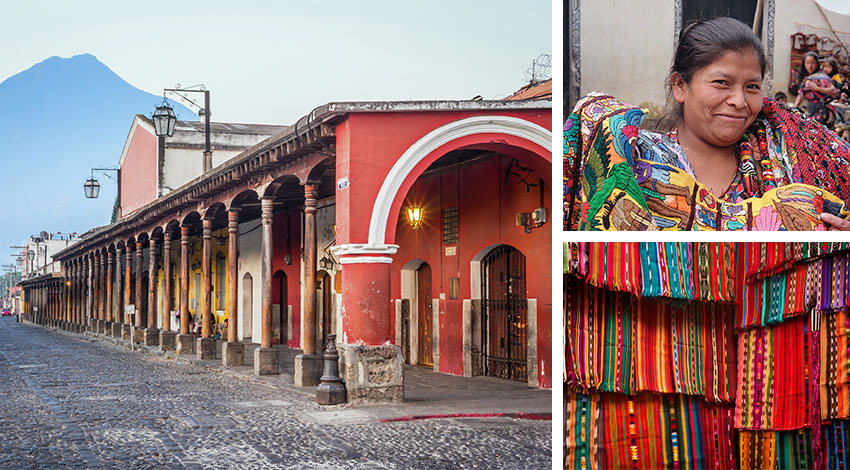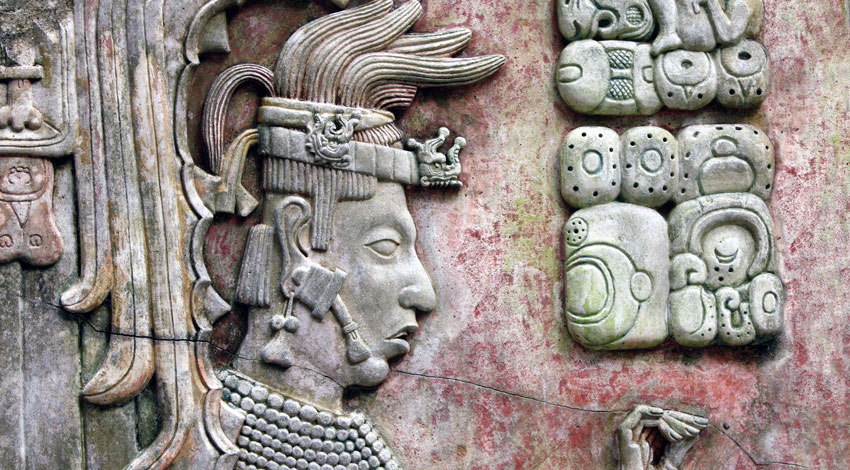Guatemala Culture Chronicles - The Colors of Mayan Traditions
A country is its people. As home to some of the most spectacular Mayan ancestral communities in Central America, Guatemala has a population that is over 40% indigenous. There are more than 20 dialects of the Mayan language still being spoken. The Peace Accords, signed in 1996, mandate that Mayan now be taught in public schools. This acknowledgment of the importance of the country’s indigenous inhabitants is crucial.

Photos of Tikal, Lake Atitlan, and Guatamalan indigenous women.
At Road Scholar, our Guatemalan learning adventures are first-timer favorites for many reasons. One of our first stops on a Road Scholar program was Tikal, the iconic ancestral Mayan community. Tikal is the stuff of legend. It rises like an apparition out of the jungle, appearing like a dream or a vision. I climbed to the top of the Lost World pyramid and gazed out across the vast expanse of trees. From this vantage point, you can see where filmmakers shot the Millennium Falcon landing on the rebel base in the first “Star Wars” movie.
Strolling through the market in Chichicastenango, you can hear Mayan being spoken by colorfully dressed women who come from nearby communities to buy and sell everything from weavings to produce. The churches, products of Spanish colonialism, often have Mayan shrines inside them to accommodate those who accepted Catholicism and those who did not, which the Peace Accords mandated. With the scent of copal drifting up from the fires built on the church steps and the sounds of Catholic prayers translated into Mayan, this country is the essence of syncretism.
When I was 12, I was in Guatemala with my family. One of my clearest memories is being at the market in Huehuetenango and watching a regiment of goose-stepping soldiers parade their way through the streets. That was at the beginning of the civil war. This time, I had the honor of sitting down with two ex-combatants from the war, Melvin and Beatrice, who had survived their country’s brutal genocide as guerrilla fighters in the mountains of the Guatemalan highlands. They now live in a community called Nuevo Horizonte. The community raises cattle and farms tilapia. As I spoke to Beatrice about her experiences, I realized she was not much older than I was when the war started. She grew up with a gun in her hands. Many of us left with tears in our eyes. I am still carrying that moment in my mind.
We visited a Mayan school along the Rio Dulce, Ak’Tenamit, where the students must get up at 4 a.m. every day to arrive at school via school boat by 7. They are assigned chores for the daily operation of their school. Tuition is 200 pounds of corn per family. The families also work for the upkeep of the school; the mothers cook, and the fathers farm. They make over 15,000 tortillas a day. These kids are grateful for their education. They are proud and work hard. Many of us took school supplies and made a donation for this school’s continued success. We talked about that school for days.

Antigua, a Guatamalan weaver, and textiles at Chichicastenango.
We visited women’s weaving and medicinal collectives in San Juan La Laguna on Lake Atitlan. These communities are thriving because the women have reclaimed their traditions and taken charge of their futures. They are fearless and beautiful, like most of the people we met in Guatemala.
This program epitomizes the power of Road Scholar: to create connections, to make the world a more intimate place, to learn by sharing and, hopefully, to positively impact the places we visit and the people we meet. To be able to be the conduit through which people share stories and learn is a great responsibility. And a great honor.

Bas-relief carving of Mayan king Pakal, Palenque, Chiapas, Mexico.
Mayan History in Guatemala
To understand Guatemala culture, it’s essential to start at the roots. Mayan history in Guatemala runs deep, spanning thousands of years. As one of the most advanced pre-Columbian civilizations in the Americas, the Mayans thrived in various parts of Central America, including Mexico, Belize, Honduras, El Salvador and Guatemala. With the peak of the Mayan civilization thriving between the sixth and ninth centuries, the Mayans have had a significant impact on the cultures of Latin America, including Guatemala. Let’s dive into some of the key aspects of Mayan history in Guatemala:
- 2000 BC to 250 AD: Known as the Ancient Maya Period, this was the start of the Mayan civilization in Guatemala, where Mayans began to establish small agricultural communities and engaged in trade with other Mesoamerican cultures.
- 250 AD to 900 AD: Defined as the Mayan Classic Period, this is when many Mayan cities hit the height of their reign. Mayans made significant contributions to astrology, writing, architecture, language, religion, agriculture, mathematics and more.
- 900 AD to 1523: The Mayan Postclassic Period was another stretch of prosperity, where Mayan cities reached their densest populations. However, the civilization became more fragmented as it grew.
- 1523: The Spanish landed in Guatemala, with colonizer Pedro de Alvarado defeating the indigenous Mayans and converting Guatemala into a Spanish colony. This marked the end of the Mayan civilization.
- Colonial period: The colonial period was a time when Guatemala was ruled by the Spanish, which ended in 1839 when Guatemala became fully independent.
- Post-independence: The post-independence period of Guatemala is characterized by a string of conflicts, human rights violations, social reforms, and instability. During the 36-year civil war between 1960 and 1996, hundreds of thousands were killed, with several regimes overthrown by military coups.
Mayan history in Guatemala is long and storied, with the Mayans playing a crucial role in shaping the current culture. Today, indigenous Mayans continue to fight for representation, and many ancient Mayan historical sites, like Tikal, play an integral part of Guatemala’s cultural heritage

Vibrant Guatemala Culture, Traditions, and Mayan Festivals
As of 2023, Guatemala’s population stands at around 18.2 million people. You will find great diversity, culture and traditions within this population. Guatemalan culture is a rich tapestry woven from a blend of Mayan traditions, colonial influences and contemporary innovations from technological advances and other forms of progress.
For those looking to discover Guatemala Mayan culture, you will find a deep contrast between various sects of Guatemala Mayan people, with poor Mayan villagers occupying the rural lands and more affluent Mayans residing in urban centers. The descendants of Spanish conquistadors and Mayans, known as ladinos, are known to be part of more powerful Guatemalan families, as mixed-race descendants were thought to be purer to colonizers. Today, generational wealth can be seen between mixed and indigenous Mayans throughout Mayan culture.
However, strides have been made to incorporate indigenous Mayan customs into the present-day culture. Several schools across Guatemala offer Mayan languages to students, particularly in regions with higher indigenous Mayan populations like Quetzaltenango. There are 21 different Mayan languages spoken throughout the country, with more of these languages found in rural areas.
Another Guatemalan culture highlight stems from religion. When the Spanish arrived in Guatemala, they converted many indigenous Mayans to Roman Catholicism. However, many indigenous populations of today have slowly reclaimed their spiritual roots by integrating indigenous Maya religion with Christianity, which can be found in religious rituals and ceremonies. Many indigenous Mayans also wear traditional clothing, known as traje, which boasts intricate designs, textiles and colors related to their cultural significance.
Other Guatemala culture and traditions relate to Mayan festivals. Some popular Mayan festivals you can witness or partake in today include:
- K'iche' New Year: In the highlands, K’iche’ Maya celebrate their new year with a distinct ceremony that starts at the beginning of their 260-day calendar, known as Tzolk'in or Chol Q'ij. The start of this agricultural calendar involves rituals, ceremonies and traditional dances.
- Día de los Muertos: Like many countries in Central and South America, a popular festival in Guatemala is Día de los Muertos, known as Day of the Dead. The Day of the Dead in Guatemala incorporates unique Mayan customs to honor loved ones who have passed with elaborate graveside decorations, food offerings, candlelit ceremonies and decorated altars.
- Semana Santa: While Semana Santa draws on Roman Catholicism, this weeklong celebration leading up to Easter infuses Mayan customs for a unique Guatemalan tradition. Holy Week consists of elaboration processions and colorful street carpets called alfombras made of dyed sawdust and flowers.
These are some of the Guatemala culture and traditions you can enjoy when visiting this Latin American country.
Mayan Cuisine
One of the top highlights of immersing yourself in Guatemalan culture is the ability to enjoy authentic Mayan cuisine. Mayan cuisine is rooted in rich agricultural traditions from ancient Mayan civilizations. With diverse flavors, native ingredients and a combination of ancient and modern cooking techniques, Mayan cuisine is worth the try on any visit to Guatemala. Some key aspects of Mayan cuisine and popular dishes include:
- Corn: Maize, known as corn, is one of the most popular ingredients found in many Mayan dishes. Corn holds cultural and symbolic significance and is used in various forms, from tortillas and tamales to beverages like atole.
- Black beans: Another key ingredient in Mayan cuisine is black beans, which are a common protein source that’s served alongside rice, tortillas, or inside tamales.
- Pepián: Pepián is a traditional Mayan stew that often includes meats, vegetables and spices, known for its flavorful sauce.
- Kak'ik: Kak'ik is another Mayan dish from the Q'eqchi' Maya culture and is a spicy turkey soup with achiote, chilies and spices.
On small-group tours with Road Scholar, you can immerse yourself in Guatemala culture to taste authentic Mayan cuisine firsthand.
Want to Learn More?
Explore the colorful culture and enduring legacy of Guatemala on a Road Scholar learning adventure.
